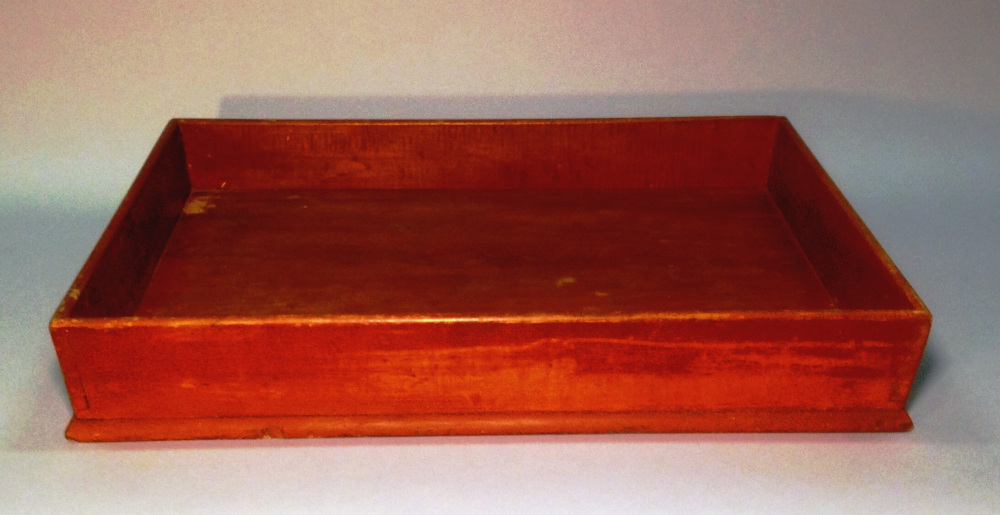
Washstand Gallery, Enfield, CT, ca. 1850, Shaker Museum | Mount Lebanon: 1961.13001.1. Staff photograph.
The Shakers’ communal furniture pieces were often larger than those used in single family homes, so when those pieces found new uses outside Shaker villages they were sometimes altered and reduced in size: benches made to seat eight to ten Shakers might be shortened to serve in a family entryway as a place to sit and put […]
The Shakers’ communal furniture pieces were often larger than those used in single family homes, so when those pieces found new uses outside Shaker villages they were sometimes altered and reduced in size: benches made to seat eight to ten Shakers might be shortened to serve in a family entryway as a place to sit and put on shoes; communal trestle-style dining tables that once fed 12 to 16 Shaker brothers or sisters have been shortened to seat the storied nuclear family; and tall 10-drawer cases have been cut in half to become four- or five-drawer bureaus. Often these alterations were done by outsiders who bought surplus furniture from the Shakers. Sometimes, however, these alterations were done by the Shakers themselves. For example, on January 18, 1884, a South Family scribe (Shaker Museum | Mount Lebanon, mss. no. 21485) recorded in the family journal that Samuel Shumway, a non-Shaker resident of the town of New Lebanon who was often hired to do carpentry and cabinetmaking for the Shakers, “cut a door thro the porch into the Deaconesses room [and] cut a large case of drawers into [i.e., in two] – half goes in the North garret, the other half remains in the porch.”
While it is not known if the object that is the subject of this article resulted from the intentional alteration of a piece of furniture or something more tragic, it was clearly once part of something larger. When cataloged into the collection it was identified as a “drawer.” Upon recent examination the remnant has been identified not as drawer, but as a four-sided gallery that likely sat atop a small case of drawers to make a piece called a washstand. Before the advent of indoor plumbing and sinks for personal wash-ups, washstands were common in Shaker and non-Shaker dwellings. The pieces took many different forms, but often had a back-splash or a gallery to contain any leaks, spills, or splashes from an ever-present water bowl and pitcher.

Washstand Gallery, Enfield, CT, ca. 1850, Shaker Museum | Mount Lebanon: 1961.13001.1. Staff photograph.

Washstand Gallery (underside of bottom), Enfield, CT, ca. 1850, Shaker Museum| Mount Lebanon: 1961.13001.1. Staff photograph.
The gallery has several distinctive features. The sides are made of a tight-grained curly maple. The right and left sides and the front side all flare out slightly. The four sides are dovetailed together. The underside of the gallery bottom has long grooves along its right and left side that were made to receive the plank side boards of the case piece upon which it sat and in the center of the front of the underside, between these grooves, is a small rectangular mortise that likely once secured the tenon of a divider that separated two drawers in the washstand. There are also small rectangular holes just inside the gallery walls that were made by nails that secured the gallery to its base. These details, taken as a whole, suggest a strong connection between this gallery and the galleries of several washstands that have been attributed to Brother Abner Allen (1776-1855), a known Shaker cabinetmaker from Enfield, Connecticut. One washstand with a similar gallery (see below) is in the collection of Hancock Shaker Village. While the dimensions of the gallery on this washstand – 3 ½” high by 27 7/8” wide by 19 ¼” deep — do not match those of the gallery in the Shaker Museum’s collection – 3 1/4” high by 23 ¾” wide by 17 5/8” deep – all of the other characteristics of the complete washstand gallery compare favorably with the displaced gallery.

Washstand, Enfield, CT, ca. 1850, Hancock Shaker Village: 1989.2. Timothy Rieman, photographer.
Brother Abner was known to favor figured wood – especially curly maple. He seemed to have an affinity for dovetailed joints that are not joined at right angles. The protruding edges of the bottoms of the galleries on both examples terminate in the same thumb-nail shape. The most noticeable difference between the two examples is that the gallery in the Shaker Museum’s collection is painted red while the complete washstand is not. It is, of course, conceivable that the complete washstand, at some point, had its paint removed to expose the beauty of the curly maple. If this is the case, it is an interesting piece of information to think that Shakers made furniture from wood known for its decorative appearance and then obfuscated most of that feature with paint.
Since this piece was acquired in 1961 at Mount Lebanon and was most likely made at Enfield, Connecticut, it is likely that the washstand from which this gallery was separated was brought to Mount Lebanon, maybe with Elder Walter Shepherd and Brother Daniel Orcutt when Enfield closed and they moved to the North Family at Mount Lebanon.
Shaker Museum | Mount Lebanon is currently migrating its collection records to a web-based public database thanks to a grant from The Henry Luce Foundation. In the process, much of the collection is being re-examined, allowing us to make sense of and flesh out the stories of pieces in the collection.